Sutherland project will shape historic reburials policy
05 November 2019 | Story Helen Swingler. Photos Je’nine May. Read time 10 min.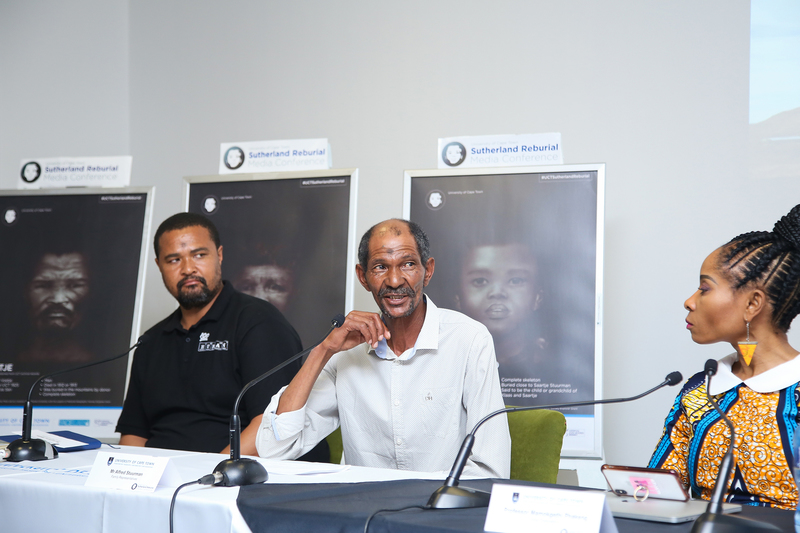
The Sutherland Reburials Project, involving nine sets of San and Khoe skeletal remains unethically obtained by the University of Cape Town’s (UCT) medical school between 1926 and 1931, provides a precedent for shaping national policy on historic reburials.
This was mooted at a press conference at UCT on 4 November, where the scientific results of a multidisciplinary and multi-institution investigation of these remains were released. The project involved nine academics and eight postgraduate students, who worked closely with descendants of the individuals and their community in Sutherland, Northern Cape.
The remains were found during an archiving audit of the university’s skeletal collection in 2017 by UCT’s Dr Victoria Gibbon, the curator of human remains at the Faculty of Health Sciences. Nine of these individuals were brought to the university by a medical student from Kruisrivier Farm, Sutherland, in the early 20th century.
The available records detail the first names of seven of the individuals and the surnames of two: Abraham and Stuurman, whose descendants still live in the area.
The scientific studies have established the gender and identity of the individuals, reconstructed their faces, provided insights into where and how they lived, what they ate, how they died and whether they were related.
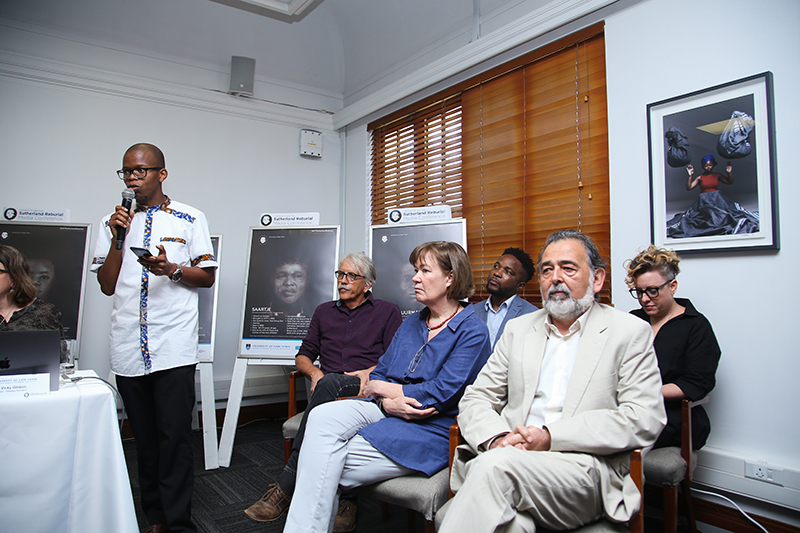
The collaborative project was led by Deputy Vice-Chancellor for Transformation Professor Loretta Feris and the Office for Inclusivity and Change, and included public participation consultant Doreen Febuarie, members of the Sutherland Abraham and Stuurman families, and community members.
“Not a proud moment”
Feris said the discovery of the skeletons had “not been a proud moment” for the university.
“We apologise to the nation and to the communities that we were complicit in obtaining these remains in an unethical manner.”
“We walked this process, with the leadership of the San and Khoe, local and national government representatives, in a very mindful manner in terms of ethics and care.”
The academic team also conducted a survey of the Kruisrivier farm cemetery where the skeletons had been buried, did an in-depth analysis of the disturbed graves, and examined the history of the farm and the Roggeveld area where the farm is located.
The Roggeveld region’s history reveals that it was a zone that was bitterly contested between the San and Khoe communities and the colonialists. The communitiesʼ resistance to the colonialists’ steady encroachment began in the 1740s and continued well into the 19th century, creating genocide.
The subjugated San and Khoe, some still children, were used as indentured labour on the farms. The remains found on the farm carried this weight of history and injustice.
Feris said: “We walked this process, with the leadership of the San and Khoe, local and national government representatives, in a very mindful manner in terms of ethics and care. Restorative justice guided us.”
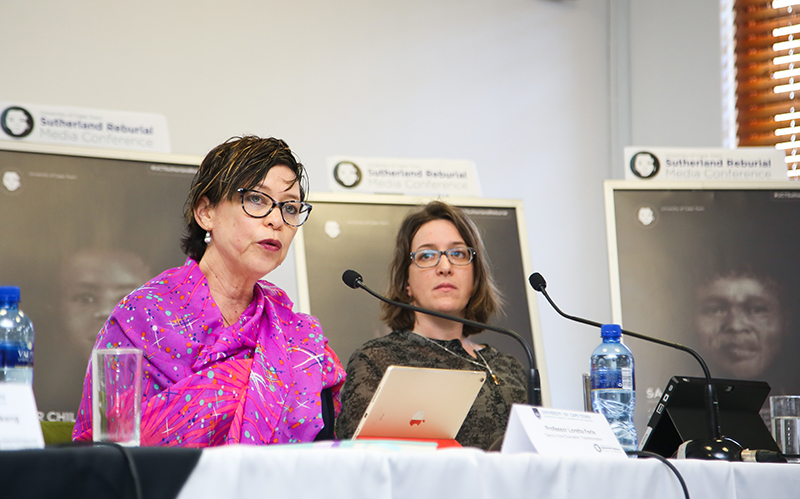
Speaking at the media conference, Vice-Chancellor Professor Mamokgethi Phakeng said: “Our priority was to reconnect them [the remains] with their families, to their past and to their own story… The fact that we were able to do so means we were able to participate in a process that has been transformational for all or us: for the university, for the Sutherland community and for South African society.”
The process also demonstrated the importance of collaboration, involving the Sutherland Abraham and Stuurman families, the community leaders and government officials who facilitated the exchange sessions.
“This process also demonstrates the power of academia to help restore national pride, identity… This kind of work is not possible anywhere but at a university, which has the required resources, including committed academic staff to provide the necessary research, access to historical records, high standards of academic rigour to establish the best likelihood for historical accuracy, collaborative relationships across academic disciplines to develop a holistic picture of the persons who left these skeletons, and the ability to collaborate with other universities and with organisations like the National Geographic Society [which sponsored the facial reconstructions].”
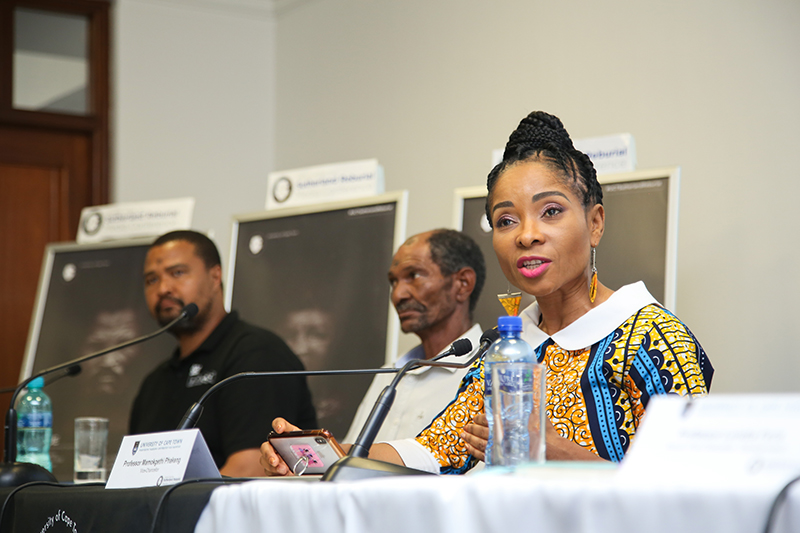
Phakeng said that the importance of the findings was deeply significant for the country and an acknowledgement of the deep historical roots of the San and Khoe in that area of the Northern Cape.
“Providing this sense of identity is an important part of building national pride, justice and democracy. We need to know who we are.”
“The heritage of the Sutherland community and the families represented by these skeletons is no longer based on just oral history. We now have concrete evidence. Providing this sense of identity is an important part of building national pride, justice and democracy. We need to know who we are.”
Ongoing process
But this is not the end. The process and collaborations with stakeholders will be ongoing, said Feris. The process of reburial will now take centre stage, not at the original place on the farm but in a historic cemetery in Sutherland where the community will have better access to the graves. This will take place in early 2020.
Representative of the Sutherland Abraham and Stuurman families Anthony Mietas said it had been a remarkable journey for the families and community, but that the journey had been about restorative justice and redress rather than scientific output.
“This is about restoring the dignity of our ancestors. At one point of our lives we are all confronted with the questions: Who are we? Where do we come from? What is our heritage? This is as a result of a brutal system called apartheid in South Africa.”
He added: “However, from great difficulties arise opportunities as well. If it wasn’t for the integrity of this university with the discovery of the remains in February 2017, we would not have known that our ancestors’ remains were at the university.”
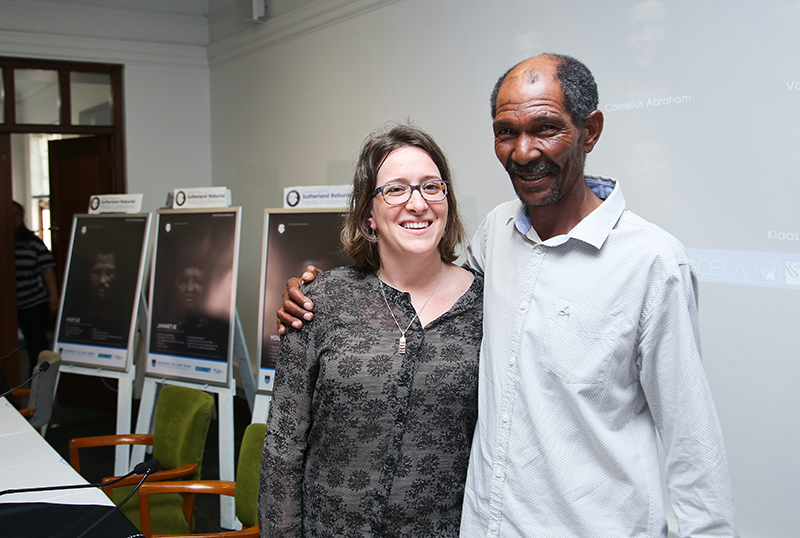
Gibbon, the science project lead, said the immense value of the scientific process had been in yielding “one of the most comprehensive sets of analyses completed in a restitution project globally”.
“Together we have brought a picture of what life was like for these people in Sutherland in the late 1800s. The interdisciplinary team of researchers, from arts, humanities, natural, social and health sciences involving international and local team members, with the families and their community, have been incredible partners – and have shown the immense value of interdisciplinary and community collaboration.
Hard lives
“The analyses of these people provide glimpses of the San and Khoe in the late 19th century. The recomposition showed that life was physically hard, conditions such as tooth decay caused death and there was a good deal of violence and many children lost their parents.
“Despite these challenges, these people maintained their cultural identity, shown in grave style and the way they sat. They show us hard-working people who faced difficult circumstances with perseverance and resolution.”
The Sutherland families and community have asked for a book to be compiled, capturing their stories.
“They would like their stories to be widely known,” said Gibbon.
“Where is the deep historical recognition for the San and Khoe people of this area? It’s missing.”
The project will also ensure a balance in what attracts people to this remote community. Today tourism in Sutherland is geared towards space and stargazing. But there are more immediate mysteries and Gibbon asked: “Where is the deep historical recognition for the San and Khoe people of this area? It’s missing.
“They want knowledge, information of their history to be acknowledged and preserved for their children. A celebration of these strong historical linkages [to] these nine individuals has brought us together and provided a platform to do this.”
Gibbons said that a memorial has been planned for Sutherland to commemorate the San and Khoe people’s deep historical roots in the Roggeveld.
“This will be completed with [many levels of] government, the Sutherland community and the Abraham and Stuurman families and the university’s researchers.”
Addressing the community members and families present, Gibbons said: “This process has established a significant bond with these families and the people in the region, and we look forward to our continued role in this journey with you.”
 This work is licensed under a Creative Commons Attribution-NoDerivatives 4.0 International License.
This work is licensed under a Creative Commons Attribution-NoDerivatives 4.0 International License.
Please view the republishing articles page for more information.
UCT Sutherland Reburial
After an archiving audit of the UCT Human Skeletal Collection in 2017, the university discovered that it had 11 skeletons in its collection that were unethically obtained by the institution in the 1920s. The university has acknowledged this past injustice, which forms part of its history. Nine of these individuals were brought to the university in the 1920s from Sutherland in the Northern Cape. UCT is working with the community of Sutherland to return the skeletal remains of these nine individuals to their descendants. An interdisciplinary team of academics from UCT and two international partner institutions have conducted unprecedented scientific studies. This process has enabled the university to provide redress and social justice through science.
On 26 November 2023, remains of the nine individuals were reburied in Sutherland. Read the latest news.



























